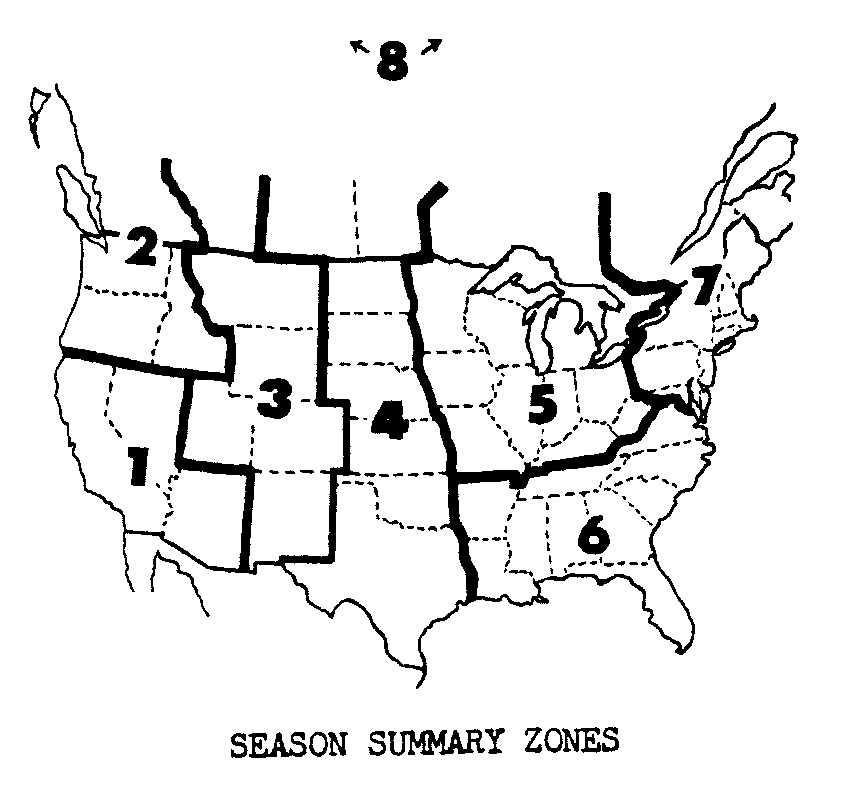The Lepidopterists’ News
THE MONTHLY NEWSLETTER OF THE LEPIDOPTERISTS’ SOCIETY
c/o Osborn Zoological Laboratory, Yale University, New Haven 11, Connecticut, U.S.A.
| Editor - C. L. REMINGTON |
Assoc. Editor - J. E. REMINGTON |
| Volume II |
Supplement |
THE FIELD SEASON SUMMARY OF NORTH AMERICAN LEPIDOPTERA FOR 19481
The field observations of North American Lepidoptera for the 1948 season were somewhat improved over last year, when this project was initiated. However, they are disappointing in view of the large number of careful observers who failed to participate and in view of the complete lack of information on many regions and the scarcity of records of moth occurrence, migration, and parasitization.
The broad pattern of Lepidoptera occurrence in North America indicated an average year, with considerable differences between Areas.
 |
Mention of reduction of Lepidoptera from DDT spraying came from Washington and the Carolinas.
In this year’s summary much information was accepted which would be excluded or published in other issues of the Lep. News in future years. ... An effort was made to use uniform names for species and genera. In most cases the nomenclature of the McDunnough Check list has been used, but a few more up-to-date names have been used. Most subspecific names have been omitted because the races are geographic in all American cases known to us. Authorities’ names have been omitted since they are not necessary for this sort of project.
|
C.L.R. |
4. GREAT PLAINS- TEXAS AND EASTERN PLAINS OF ROCKY MTS. STATES
TO SASKATCHEWAN AND MANITOBA
by Don B. Stallings
Caldwell, Kansas
SOUTH2
The season in Texas was slightly below normal
as the past year had been unusually dry. The spring cold spell for the
Great Plains extended into the Rio Grande Valley area. Anthocharis midea [Falcate Orangetip3] was taken at
Pleasanton, Texas, on March 3rd. Pupae and larvae of Megathymus yucca
[Yucca
Giant-Skipper] taken at San Antonio, Texas, on this date and brought
back to Kansas did not emerge until after the middle of April, though
kept in a warm room. Normally this species would be in flight in
southern Texas from the end of February through March.
In the Rio Grande Valley the following species were abundant:
| Atlides halesus | Great Purple Hairstreak |
| Strymon clytie | Clytie Ministreak |
| Hemiargus cyna | Cyna Blue (Zizula cyna) |
| H. gyas | Ceraunus Blue (Hemiargus ceraunus) |
| Asterocampa clyton | Tawny Emperor |
The following species were about average:
| Ascia josephina | Giant White |
| Danaus eresimus | Soldier |
| Myscelia ethusa | Mexican Bluewing |
| Apodemia walkeri | Walker's Metalmark |
| Strymon azia | Gray Ministreak |
| Incisalia henrici | Henry's Elfin (Callophrys henrici) - doesn't occur south of San Antonio |
| Astraptes fulgerator | Two-barred Flasher |
| Cogia calchas | Mimosa Skipper |
| Amblyscirtes bellus | Orange-edged Roadside-Skipper (Amblyscirtes fimbriata) [No TX Records] |
| Cabares potrillo | Potrillo Skipper |
| Asterocampa leilia | Empress Leilia |
The following species were scarce:
| Papilio ornythion | Ornythion Swallowtail |
| P. polydamus | Polydamus Swallowtail |
| P. anchisiades | Ruby-spotted Swallowtail |
| Anteos clorinde | White Angled-Sulphur |
| A. maerula | Yellow Angled-Sulphur |
| Strymon pastor | Laviana White-Skipper (Heliopetes laviana) |
| Thecla bazochii | Lantana Scrub-Hairstreak (Strymon bazochii) |
| Mitoura xami | Xami Hairstreak (Callophrys xami) |
| Lerodea tyrtaeus | Violet-patched Skipper (Monca crispinus) |
| L. edata | Olive-clouded Skipper (Lerodea arabus) ??? 4 |
| Lasaia sessilis | Gray Bluemark (Lasaia maria), probable mis-ID of Blue Metalmark (L. sula) |
| Cogia outis | Outis Skipper |
| Pellicia costiinacula | Glazed Pellicia (Pellicia angra) ??? |
New records were:
| Proteides mercurius | Mercurial Skipper |
| Cobalus percosius | Double-dotted Skipper (Decinea percosius) |
The coverage in Area 4 is still poor, this summary being based on the observations of three groups of collectors with no report to cover the Dakotas or Nebraska. Collectors from other areas who stop in the Great Plains even a few days should write reports.
-------------------------------------------------------------------------------------
Contributors: P.F. Bruggemann; H.A. Freeman; J.R. Turner.
1Charles Remington's opening summary comments were edited for
brevity.
2North and Middle reports were omitted from Region 4.
3English names added.
4Questionmarks indicate best guess.
06 Mar 2011 - Mike Quinn / entomike@gmail.com / Texas Entomology